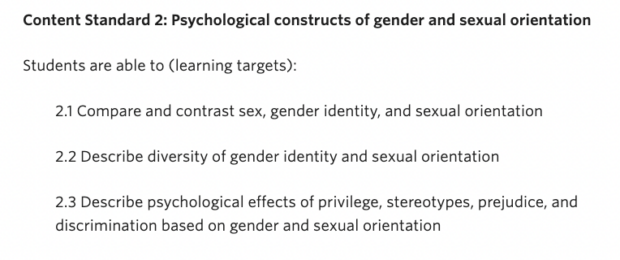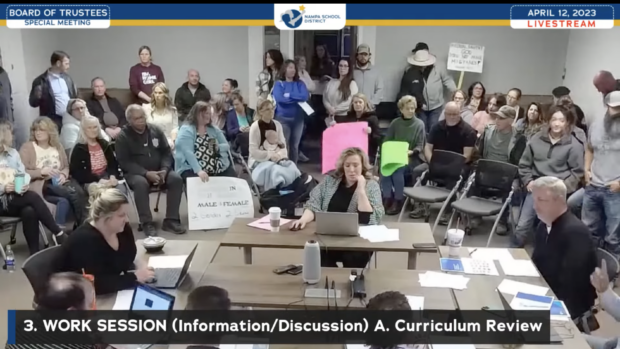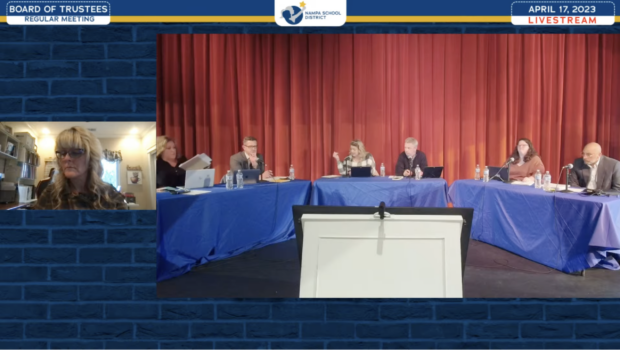Opposing views on gender identity — and whether the concept should be taught in secondary schools — dominated a Nampa School Board meeting Monday night.
At issue was an introduction to psychology class that covers information about gender identity, as part of high school curricula established by the American Psychological Association.
The contention started when a Nampa High School parent raised concerns with a psychology quiz — particularly, with some questions related to gender and sexuality (those questions are reprinted below).
News about the quiz and class spread via social media, spurring more than 50 people, some with signs, to fill the Skyview High auditorium Monday night. Nearly 100 additional viewers streamed the meeting online.
Ultimately, trustees made no decisions about the class (they’ll plan to do so at a later date). Instead, they listened as nearly 40 patrons came to the podium.
Speakers included current and retired teachers, parents, a student, community members, and some out-of-towners; most opposed the gender identity curriculum.

A few, like Gary Nelson, were California transplants who came to Idaho at least partly to find refuge in a more conservative state. They said they were alarmed to hear about gender identity being discussed in Nampa.
“It’s just gut wrenching to see it going on here,” Nelson said.

The APA defines gender identity as “one’s self-identification as male or female,” which is influenced by societal structures, cultural expectations, personal interactions, and environmental and biological factors.
Cassie Hugo, a Nampa High student, said she was in the psychology class in question and felt it was one-sided, covered overly controversial content, and downplayed the importance of family values.
Her mother, Natasha Hugo, said she was “very disappointed that the one institution I trusted is now the institution I feel I need to protect my child from.”
Distrust of local schools seemed to be a common thread among opponents of the gender identity curriculum. Megan Hayward said she pulled her students out of public schools three years ago and it was “the best decision (she) ever made.”
“I can’t trust our teachers in this district,” she said. “I cannot trust our school board in this district to uphold the values of this community.”
Nampa resident Larry Mcclintock said the gender identity curriculum “is evil and damages our children mentally, physically, emotionally, and spiritually. … Teaching our youth that there are more than two genders goes against science and godly truth and erodes our families and societies.”
Mcclintock threatened to campaign for the trustees’ removal if they didn’t ban the curriculum, a pronouncement met with applause.
But other patrons supported classroom discussions of gender identity.
“Without allowing our children to be exposed to and taught how to wrestle with a plethora of perspectives, including ones that are antithetical to their own, we are failing to fulfill the fundamental purpose of preparing critical thinkers, which in turn robs us as a society of our future,” Stephanie Binns said.
And Jaci Johnson said prohibiting such discussion was dangerous: “Rejecting these topics serves only one purpose: to prevent open discussion and isolate our kids from different viewpoints. Withholding specific information from students with the purpose of isolating them from different ideas is the very definition of indoctrination.”
Kara Hudson has a student at Nampa High who took the psychology course in question in 2020. Hudson said it was “a lifesaver” for her child, the only class that got her excited about school.
Hudson also has an adult son who is transgender. Hudson grew up as a conservative Christian and never had exposure to gender identity concepts, which she said was a detriment.
“Fortunately, he survived me … he survived that I did not understand what he was going through at that time,” she said.
She said she would understand parents opting their children out of the psychology class, but said it wouldn’t be fair to ban the course or gender identity curriculum for all. Doing so would be “telling me that my child gets to be erased because somebody doesn’t like who they are,” Hudson said.
The quiz and class that provoked controversy
Here’s how the gender curriculum went from being one parent’s concern to a flashpoint in the Nampa School District:
- A Nampa High teacher gave a quiz in his Introduction to Psychology class, an elective. The parent found some questions inappropriate.
- The complainant, Stacey Stanciu, contacted district officials (according to the school district and based on information from the board meeting).
- Superintendent Gregg Russell, a board member, and the board clerk met with Stanciu on April 10.
- The board then took up the issue at an April 12 work session, which more than 30 patrons attended, some holding up signs during the meeting (online groups had encouraged people to attend). Trustees decided to put the curriculum review on the agenda for Monday’s board meeting so patrons could testify.

The quiz in question contained a handful of questions pertaining to gender and sexuality. The quiz can be read in full here, but the questions that seemed to generate the most concern are below:
- Given the following definition, how many sexes are there?
“Sex is the biological and physical manifestation of a person’s chromosomes at birth.”
- Fewer than two.
- Two.
- More than two, but fewer than ten.
- A currently indeterminate amount.
Answer: 3
- Is a person’s sex a choice?
- Yes.
- No.
- It depends on who you ask.
- Research is currently inconclusive.
Answer: 2
- Given the following definition, how many genders are there? “Gender is a sociological construct of both how one sees oneself and society’s expectations of masculinity and femininity.”
- Fewer than two.
- Two.
- More than two, but fewer than ten.
- A currently indeterminate amount.
Answer: 4
- Is gender a choice?
- Yes.
- No.
- It depends on who you ask.
- Research is currently inconclusive.
Answer: 3
Parents against the gender identity curriculum took umbrage with some of the correct answers. They insisted repeatedly, often to applause, that there are only two genders — male and female.
The introduction to psychology class is a prerequisite to dual credit psychology classes. The course has been offered for at least 30 years, but course instructors began using an updated curriculum called OpenStax in 2019 — one that was not officially approved due to a miswording snafu during a board meeting that year.
The mistake was not realized until recent complaints arose.
At the 2019 meeting, former Trustee Heather Lewis moved to accept curriculum recommendations, but inadvertently left OpenStax out of her list of curriculum providers.
Parents have seized on the mistake as further reason to eliminate the gender identity curriculum from the Nampa district.
It wouldn’t be the first ban on LGBTQ ideology in Nampa classrooms.
Nampa currently does not allow transgender or LGBTQ pride flags in its schools, and teachers are not allowed to ask students about their preferred pronouns.
What next: trustees will consider banning the curriculum or adding parental oversight
Trustees plan to meet with legal advisors next week to discuss their options regarding the class and gender identity curriculum. Afterward, they’ll decide when to make a decision.
Their options include banning the curriculum, or keeping it but adding more parental oversight. The latter could involve requiring parents to complete an “opt-in” form for the psychology class and other courses containing gender identity curriculum.
Trustees have also discussed developing a system where parents are notified online whenever their child signs up for a new class. At registration, each class could also have its standards listed for parents to review.
Stanciu, the complainant, said in a written statement read aloud Monday that she would support a parental opt-in process. “A lack of transparency of academic topics and standards being taught in our classrooms is a violation of students’ rights.”
After the public comments Monday, Trustee Tracey Pearson was outspoken about her desire to ban gender identity curriculum.
Pearson said that gender dysphoria is “a mental health problem. And it’s not something that should be encouraged.”

Trustee Jeff Kirkman suggested that if parents wanted their students to be informed about gender identity, they could teach that at home.
But later, he seemed to second-guess himself and wondered if students would really have out-of-district support systems if they wanted the information and it were removed from the curriculum.
Trustees also questioned the national standards that guide the course’s curriculum, preferring standards tailored to Idaho.
Kirkman suggested they could “do a little bit of shopping” for standards that better suit Nampa. Idaho has no K-12 psychology standards in place.
Editor’s note: Patrons at the meeting said their names aloud, but did not spell them. The spelling of their names may not be accurate in every case because of that. Please let us know if your name is misspelled and we will correct it.
